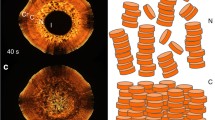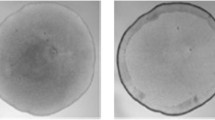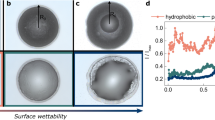Abstract
Droplets are of great scientific interest because studying their formation and dynamics is important in many technologies such as in microfluidics [1, 2]. Evaporation of droplets is another interesting aspect that has caught much scientific attention. An example of an evaporating droplet is a coffee droplet spilled on a table. After evaporation the coffee droplet leaves a ring-like stain called a coffee ring or coffee stain [3]. This phenomenon, known as the ‘coffee ring effect’, occurs not only with coffee droplets but also with all droplets containing non-volatile solutes. There are a number of interesting physical processes going on within the droplets during evaporation to form the ‘coffee stains’. In this article, we will see what they are.
Similar content being viewed by others
Suggested Reading
Todd M Squires, Stephen R Quake, Microfluidics: Fluid physics at the nanoliter scale, Reviews of Modern Physics, Vol.77, pp.977–1026, 2005.
Dileep Mampallil, Sajan D George, Microfluidics — A Lab in Your Palm, Resonance, Vol.17, pp.682–690, 2012.
R D Deegan, O Bakajin, T F Dupont, G Huber, S R Nagel, T A Witten, Capillary flow as the cause of ring stains from dried liquid drops, Nature, Vol.389, pp.827–829, 1997.
Sandeep Prabhakara and M D Deshpande, The No-Slip Boundary Condition in Fluid Mechanics, Resonance, Vol.9, pp.50–60, 2004.
Noushine Shahidzadeh-Bonn, Salima RafaBonn, Evaporating droplets, J. Fluid Mech., Vol.549, pp.307–313, 2006.
Á G Marín, H Gelderblom, D Lohse and J H Snoeijer, Phys. Rev. Lett., Vol.109, pp.085502, 2011.
Greg Huber, Viewpoint: Rush hour in a drop of coffee, Physics, Vol. 4, p.65, 2011.
Peter A Kralchevsky and Kuniaki Nagayama, Capillary Forces between Colloidal Particles, Langmuir, Vol.10, pp.23–36, 1994.
Peter J Yunker, Tim Still, Matthew A Lohr and A G Yodh, Suppression of the coffee-ring effect by shape-dependent capillary interactions, Nature, Vol. 476, pp.308–311, 2011.
F Mugele and J C Baret, Electrowetting: from basics to applications, J. Phys. Condens. Matter, Vol.17, p.R705, 2005.
See wikipedia for Leidenfrost effect.
Author information
Authors and Affiliations
Corresponding author
Additional information
Dileep Mampallil is a postdoctoral researcher at University of Twente, The Netherlands. His research interests include micronanofluidics and nanoscale electrochemistry.
Rights and permissions
About this article
Cite this article
Mampallil, D. Some physics inside drying droplets. Reson 19, 123–134 (2014). https://doi.org/10.1007/s12045-014-0016-z
Published:
Issue Date:
DOI: https://doi.org/10.1007/s12045-014-0016-z




